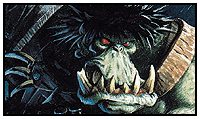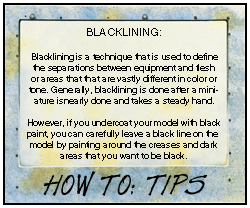
You can hear it, rumbling in the distance like the roar of a thousand cannons. A pulsating cry that invokes visions of fear, bloodlust and unbridled savagery. Waaagh, WAAagh, WAAAGH!!! With the release of the new plastic Ork Boyz unit, tons of Warhammer 40,000 players will be starting up Ork hordes to ravage the galaxy. We thought that this would be the perfect time to let our ace Greenskin painters here at Games Workshop US grab a bit of the spotlight and let all of our dedicated readers in on their secrets for painting Ork models. Without further introduction, let's take a look at what our brush-wielding Madboyz have to say:

There really isn't any difference between painting Orks and painting humans, Eldar or any other fleshy miniatures other than your palette is drawn definitively from the green color spectrum. These simple rules can be applied to any Ork or Gretchin models, but I've found that they usually work best on those units that you want to really stand out in your army. In my case, that's all of them, but then again, I'm not the fastest painter in the world!
First - Undercoat your models with black spray primer, since Orks are generally very dark in their shady bitz (ugh!) Black will enable you to get a good coating of dark green on as your basecoat. White primer will have you putting on coat after coat of green to get it even and looks a bit too bright for my taste on mean and nasty Ork Boyz. The actual painting starts with a nice, even coat of Dark Angels Green paint. You can choose to paint it on with a brush, or use one of Games Workshop's handy spray cans to apply the color, either will do. I make sure I do this because you really want your Orks to to be a very deep green, especially in their recesses. Simply painting hightlights over black won't do and makes the Orks look a bit haphazard when finished.

Third - Go over the areas you just hit with your first highlight with straight Goblin Green. Make sure that this covers a smaller area than your first highlight and don't mix your paint too thick or the tones will seem a bit unnatural. After this I continue highlighting smaller and smaller areas with a mix of Bilious Green and Goblin Green and then straight Bilious Green for the final highlight. Moving from one color to another via an intermediate mix of the previous highlight really makes the Ork flesh look smooth and lifelike. Using these techniques enabled me to win two Golden Demon awards at US Games Day 1995 (Blood Bowl Orcs) and 1996 (Warhammer Orcs) and while it may take a little more time to accomplish, I think you'll be pleased with the results!
Da Gunz n' Teef by the 'Eavy Metal Team
 When painting Ork gunz (and other metal bitz in the Ork army), use Boltgun Metal to on the casings and choppas. It usually looks good after a single coat and can be highlighted immediately with Chainmail. A wash of Brown ink will then make the gunz look corroded and weather-worn.
When painting Ork gunz (and other metal bitz in the Ork army), use Boltgun Metal to on the casings and choppas. It usually looks good after a single coat and can be highlighted immediately with Chainmail. A wash of Brown ink will then make the gunz look corroded and weather-worn.
In comparison, Tin Bitz is a much darker and browner metal color. For really filthy looking equipment, use it as a base color and highlight with Boltgun Metal to really make your Orky gear look well-used.
You can paint teeth and horns with Bleached Bone - a couple of coats will look good even over black. If you want your model's teeth to look more discolored, use a wash of Brown ink (this stuff is really useful). You can also use Bubonic Brown or Codex Grey as a base color for teeth. We painted the horns on the Nob pictured at the left with Scorched Brown first, the ridges were painted on with Bubonic Brown and then Bleached Bone.
 Da Speedsta Method
Da Speedsta Method
by Dan Bartholomew
So you're looking to get an Ork Army together fast, I mean like 200 Orks in 3 days fast? Then this is the method for you! While the following technique will not garner you a Golden Demon, it will enable you to get a fairly immense Ork force on the battlefield quickly.
To start, assemble and clean up all of your Orks as quickly as possible. Since the multipiece models are so cool, this may take longer than the actual painting as you attempt to get as many excellent action poses as you can. At this point you can base all of your models before painting as they will be already primed and ready for when you finish. Now that you've got all of that out of the way, use black spray primer to give everything a nice even coat for your paint to stick to.
Now the real painting begins as you drybrush all of your Ork skin with Goblin Green. Make sure that you don't use too much pressure and you may notice it could take two applications to get it to a decent highlight. When that's done, add a little rotting flesh to the mixture and drybrush all of your Ork skin again with even less pressure. This should be a fairly quick step and you should be able to finish them off with only one application. If your highlights are a bit too bright, take some watered down Dark Green Ink and coat the skin with a light glaze to help even everything out.
Once the skin is done, you're most of the way home and just need to finish the details on the models like pants, boots, hats and helmets. Usually dark contrasting colors like browns, black and dark blues will give your Orks a mean and brutal look. Guns and metallic items can be painted or carefully drybrushed with Tin Bitz and highlighted with Chainmail to finish them. After that, it's just a matter of painting the eyes a suitable shade of red and the teeth Bubonic Brown highlighted with Bleached Bone and you're done!
Give the bases a quick drybrush of Bestial Brown followed by Bleached Bone and you're ready to conquer the universe in the name of Gork and Mork. By using this technique and with a little practice, you can crank out literally dozens of hardened Ork Boyz in a single painting session. Remember, while you may not win any awards with this painting technique, you will have an army on the table that's ready to kick some enemy butt faster than than you can say Waaagh!!! (ok, not that fast, but they'll be on the table pretty darn quick).
 Masta Techniques
Masta Techniques
by Dave "Burna" Husser
Editors Note: While humble, Dave Husser knows how to paint Orks really well. When we asked all of our US Store Managers to send in their own newly painted Ork Warbosses into the US Promotions office for an article in White Dwarf #235, Dave's was unanimously voted as the best. If you're in the Franklin Mills/Philadelphia, PA area stop into GW Philly and take a look at Dave's work. If that's too far, just check out the picture on the left. That being said, we thought that Dave would be the perfect guy to polish off our article with some Masta Techniques for veteran Ork painters. Take it away Dave...
One of the most important things that you can do to really make your Orks (especially the characters) look special is to take lots of time making the skin tones look as cool as possible. On my Ork Warboss (which will be available around the end of July, unpainted of course -ed.) Rather than take the regular route of using a variety of different green paints to obtain my highlights, I went the tough road and used a limited color palette of only a combination of Chaos Black and Camo Green. To represent the experience and age of my Ork Nobz, I like to paint them as dark as possible, with the Warboss being the toughest and darkest of all. In total, I used about nine intermediate shades of a Black and Camo Green mixture to get the final results you see. It takes a fine eye to pick out the colors in this way as well as a pretty good understanding of the way light will fall on the model and that is why I only recommend this method for experienced painters.
Also, in order to make my Orky Commander as much of a center/showpiece for my army as possible, I added the Gretchin to offset the bleedin' 'ooge Warboss in the center of the base. By painting the Grot Assistant a pretty pale shade of green, he lends a good contrast to the centerpiece without stealing the show from the main focus of the miniature. Make sure that you choose additions for your bases that aren't too overstated or large as you may end up losing the actual subject of the piece by trying to add more character to the base. (Geez, that sounds just like something an oil painter would say, but it's true that even Citadel Miniatures can become works of art. Just take a trip to this year's Golden Demon awards on July 9th and 10th at US Games Day 1999 and you'll see just how well Games Workshop models really can be painted! - ed.)